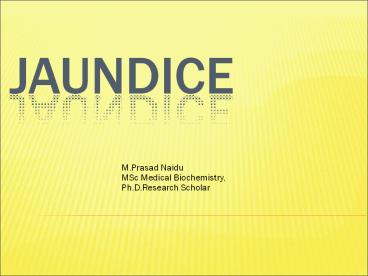JAUNDICE - PowerPoint PPT Presentation
Title:
JAUNDICE
Description:
BIOCHEMISTRY – PowerPoint PPT presentation
Number of Views:7077
Title: JAUNDICE
1
Jaundice
M.Prasad Naidu MSc Medical Biochemistry, Ph.D.Rese
arch Scholar
2
Jaundice
- Clinical marker of defect in metabolism /or
excretion of bilirubin. - ER task to initiate lab eval or imaging studies
to identify cause and determine admission or
outpt therapy.
3
Pathophysiology
- Yellow discoloration of sclera, skin, mucous
membranes due to deposition of bile pigment - Clinically detected with serum bilirubin
2-2.5mcg/dL or ? (2 times nl)
4
What is bilirubin?
- The breakdown product of Hgb from injured RBCs
and other heme containing proteins. - Produced by reticuloendothelial system
- Released to plasma bound to albumin
- Hepatocytes conjugate it and extrete through bile
channels into small intest.
5
What causes ? bilirubin?
- Overproduction by reticuloendothelial system
- Failure of hepatocyte uptake
- Failure to conjugate or excrete
- Obstruction of biliary excretion into intestine
6
Unconjugated vs. Conjugated
- Unconjugated
- ? production exceeds ability of liver to
conjugate - Ex. Hemolytic anemias, hemoglobinopathies,
in-born errors of metab., transfusion rxn.
- Conjugated
- Can produce but not excrete
- Metabolic defect
- Intra- or extrahepatic obstruction
7
Clinical Features
- Careful history and PE
- Family history (Gilbert, Rotor, Crigler-Najjar,
Dubin-Johnson, Sickle Cell) - Healthy young person with fever, malaise,
myalgias viral hepatitis (try to locate source)
8
Clinical Features
- Gradually develops symptoms hepatic/bile duct
obstruction (consider ETOH liver dz/cirrhosis) - Develops acutely with abd pain acute
cholangitis 2 to choledocholithiasis
9
Clinical Features
- Painless jaundice in older person with epigastric
mass weight loss biliary obstruction from
malignancy - Hepatomegaly with pedal edema, JVD, and gallop
CHF
10
Laboratory Tests
- Serum bilirubin level (total and direct)
- Liver aminotransferase levels
- Alk. Phos
- U/A for bilirubin and urobilogen
- CBC
- PT
- Other labs pertinent to history
- Coombs test
- Hgb electrophoresis
- Viral hepatitis panel
- U/S Gallbladder
11
Disposition
- Hemodynamically stable, new-onset jaundice, no
evidence of liver failure or acute biliary
obstruction ? discharge with follow up - If one of above violated ? admission with surgery
consult
12
Cholecystitis and Biliary Colic
- Tintanalli Chapter 85
- Pages 561-566
13
Biliary Tract Emergencies Related to Gallstones
- 1) Biliary Colic
- 2) Cholecystitis
- 3) Gallstone pancreatitis
- 4) Ascending cholangitis
14
Gallstones
- Most gallstones are asymptomatic
- Usually seen in obese females 20-40 yoa and
pregnancy (Remember fat, fertile, flatulent,
female, forty) - Associated with upper abdominal pain
15
Gallstones
- Uncommon in children (seen with hemolytic d/o,
idiopathic, cystic fibrosis, obesity, ileal
resection, long term use of TPN) - Elderly
- 14-27 symptomatic gallstone dz.
- More likely biliary sepsis/gangrenous GB
- ? perioperative morbidity
- Mortality rate 19
16
Gallstone Risk Factors
- Familial
- Asian descent
- Chronic biliary tract infections
- Parasitic infections (ascaris lumbricoides)
- Chronic liver dz (ETOH)
- Chronic intravasular dz (Sickle Cell, Hereditary
Scherocytosis) - Hepatitis A, B, C, E
- HIV
- Herpesvirus
17
Pathophysiology
- Bile
- Manufactured secreted from hepatocytes ?GB
storage in canaliculi, ductiles, bile ducts
?bile ducts enlarge ?form R and L hepatic ducts
?form common hepatic duct ?joins cystic duct from
GB to form CBD ?Ampulla of Vater ?duodenum
18
Pathophysiology
- Release of bile stimulated by cholecystokinin
secreted from small int. mucosal cells when fats
AA enter duodenum
19
Pathophysiology
- Symptomatic cholelithiasis stone migration from
GB into biliary tract with eventual obstruction
?obstruction of hollow viscus ?pain, nausea
vomiting ?acute cholecystitis
20
Pathogens Involved in AcuteCholecystitis
- E. coli/Klebsiella-70
- Enterococci-15
- Bacteroides-10
- Clostridium-10
- Group D Strep
- Staphylococcal species
21
Clinical Features
- Overlap of s/s of PUD, gastritis, GERD,
nonspecific dyspepsia - RUQ pain
- Upper abd/epigastric pain
- Radiation to L upper back
- Pain persisant lasting 2-6h
22
THANKING U































